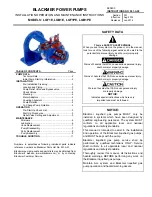
Power Supply
Technical Information
7
Power
supp
lies
●
Series Operation
•
Connect the Power Supplies in series to increase the
output voltage.
List of Main Models that Support Series Connection of
Outputs
•
The above table lists the main models for which series
connection is possible. Refer to the datasheet for each model
for details.
If models that do not support series connection are used, one
of the Power Supplies may not operate when the AC Power
Supply is turned on, possibly damaging internal circuits over a
period of time.
•
If models with different power ratings or rated voltages are
wired in series, keep the current flowing to the load below the
rated output current for the Power Supply with the lowest
power rating.
•
If the load is short-circuited when using an S82J-05024
@@
,
S82J-10024
@@
, S8VM, S8VS, or S8TS-02505
@
, reverse
voltage will occur inside the Power Supply, which may cause
Power Supply deterioration or damage. It is recommended to
connect the diodes (D
1
and D
2
) as shown in the above
diagram.
Guidelines for the type, dielectric strength, and forward current
of the diodes are as follows:
●
Backup Operation
•
Two Power Supplies can be wired in parallel even
though each has a sufficient power rating. This can be
done to ensure (back up) Power Supply even if one of
the Power Supplies fails.
(Backup operation is possible for all Power Supplies
with single outputs.)
Use the same model of Power Supply for A and B.
•
Select the Power Supplies A and B so that either has a
sufficient power rating for the load.
•
Be sure to connect diodes to both Power Supplies A and B, as
shown in the diagram, so that the Power Supply backing up
the faulty Power Supply is not affected.
Guidelines for the type, dielectric strength, and forward current of
the diodes are as follows:
•
Increase the output voltage settings of Power Supplies A and
B just enough to allow for the voltage drop (V
F
) on diodes D
1
and D
2
.
Also, make sure that the diodes are sufficiently cooled so that
their temperatures remain below the catalog value.
This is necessary to control the power loss (output current of
Power Supply I
OUT
×
diode forward voltage V
F
) resulting across
the diodes.
•
Some power loss to the load will occur due to the load power
and diodes. Therefore, do not exceed the rated power (rated
output voltage
×
rated output current) of the Power Supply.
●
Creating ± (Positive/Negative) Outputs
•
The floating output (the primary and secondary circuits are
separated) enables creating ±outputs using two Power
Supplies. To create ±outputs, connect two of the same model
of Power Supply as shown in the diagram.
•
All models of Power Supply can be used to create ± outputs. If
there is the possibility that another load is wired in series, such
as a Servomotor or operation amplifier, as shown in the
diagram, connect bypass diodes D
1
and D
2
as shown in the
diagram. Without these diodes, the Power Supplies may not
start when power is turned ON, possibly damaging internal
circuits over a period of time.
No diodes are required for models that support series
operation.
•
Guidelines for the type, dielectric strength, and forward current
of the diodes are as follows:
Model
Power ratings
Rated output voltage
S82K
90, 100 W
24 VDC
S82J
100 W
5, 12, 15, 24 VDC
50, 150, 300, 600 W
24 VDC
S8TS
25, 30, 60 W
5, 12, 24 V
S8VS
15, 30, 60, 90, 120, 180, 240 W
24 VDC
S8VM
15, 30, 50, 100, 150 W
5, 12, 15, 24 VDC
INPUT
V
1
D
1
V
L
V
2
D
2
V
L=
V
1
+V
2
INPUT
Load
•
Type: Schottky barrier diodes.
•
Dielectric strength (V
RRM
): Twice the rated output voltage of
the Power Supply or higher.
•
Forward current (I
F
): Twice the rated output current of the
Power Supply or higher.
Power Supply A
Power Supply B
D
1
D
2
Load
•
Type: Schottky barrier diodes.
•
Dielectric strength (V
RRM
): The rated output voltage of the
Power Supply or higher.
•
Forward current (I
F
): Twice the rated output current of the
Power Supply or higher.
INPUT
V
0 V
V
V
V
V
V
INPUT
Load
Load
INPUT
D
2
D
1
INPUT
Load
Load
Load
•
Type: Schottky barrier diodes.
•
Dielectric strength (V
RRM
): Twice the rated output voltage of
the Power Supply or higher.
•
Forward current (I
F
): Twice the rated output current of the
Power Supply or higher.


































